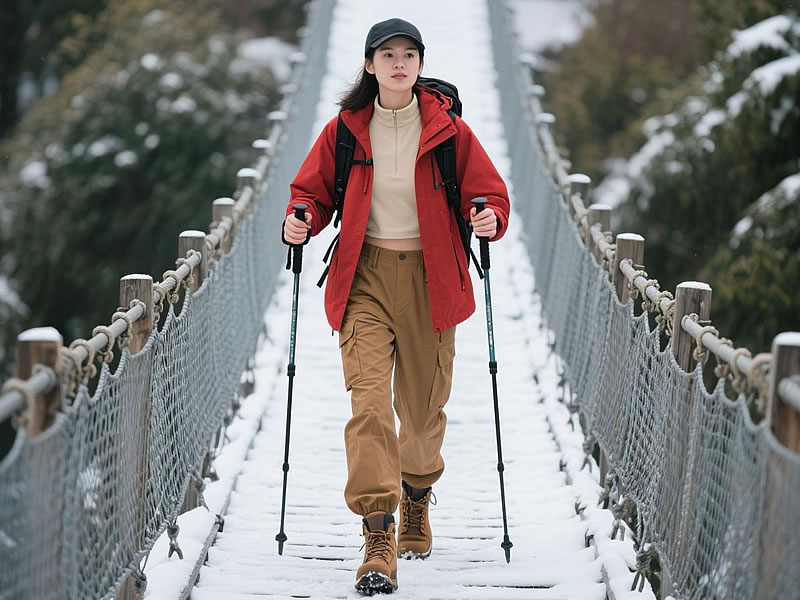Winter hiking gear list for sub-zero temperatures
Venturing below freezing demands more than grit—it requires military-grade preparation. At -20°F (-29°C), exposed skin freezes in minutes, gear becomes brittle, and mistakes turn deadly. This scientifically backed guide delivers the non-negotiable gear and survival strategies for polar expeditions or mountain winters.

The Deadly Risks of Sub-Zero Hiking
| Risk | Gear Solution |
|---|---|
| Hypothermia | 4-layer insulation system |
| Frostbite | Vapor barrier extremities kit |
| Crevasse Falls | Rope systems & ice screws |
| Whiteouts | Satellite navigation + altimeter |
Source: American Alpine Club Accident Reports
Core Heat Retention System: The 4-Layer Rule
1. Baselayer: Moisture Warfare
- Material: Merino wool (250+ gsm) or polypropylene
- Avoid synthetics that retain sweat (risk freezing during stops)
- Top Pick: Icebreaker Oasis (zonal merino weave)
2. Midlayer 1: Active Warmth
- Polar fleece or grid fleece (e.g., Patagonia R1 Air)
- Articulated elbows for unrestricted movement
3. Midlayer 2: Static Insulation
- Synthetic jacket (Primaloft Gold) or water-resistant down (800+ fill)
- Critical: Hood must fit over helmet
4. Shell: Armor Against Elements
- Gore-Tex Pro or eVent fabric
- Non-negotiables: Powder skirt, reinforced shoulders, pit zips
Extremities Protection: Where Heat Dies First
Hand System (3-Layer)
- Liner: Silkweight merino gloves
- Insulated: Mittens > gloves (e.g., Black Diamond Absolute Mitts)
- Overmitt: Waterproof shells (add chemical warmers inside)
Foot System (-40°F Rated)
| Layer | Product Example | Purpose |
|---|---|---|
| Vapor Barrier | Bread bag (yes, seriously) | Prevents sweat from soaking insulation |
| Sock 1 | Thin synthetic liner | Blister prevention |
| Sock 2 | Heavyweight merino | Primary insulation |
| Boots | Baffin Eiger (-148°F rated) | Rigid sole prevents cold transfer |
Pro Tip: Apply Sno-Seal wax to leather boots monthly.
Life-Saving Safety Gear
Shelter & Sleep System
- Sleeping Bag: -20°F (-29°C) minimum (e.g., Western Mountaineering Kodiak)
- Sleeping Pads: Two pads with combined R-value >6 (e.g., Therm-a-Rest XTherm + foam pad)
- Emergency Shelter: Black Diamond First Light or Hilleberg Soulo (4-season tent)
Navigation & Rescue
- GPS/SOS: Garmin inReach Mini 2 (mandatory for solo trips)
- Analog Backup: Suunto MC-2 compass (works at -40°F)
- Avalanche Kit: Beacon, probe, shovel (even on low-angle slopes)
Specialized Cold-Weather Tools
- Ice Axe: Petzl Quark (modular pick system)
- Crampons: Black Diamond Sabretooth (anti-balling plates)
- Water System: Insulated hydration bladder hose + wide-mouth Nalgene (store upside down to prevent cap freeze)
- Fuel: White gas stoves (Jetboil fails below 15°F/-9°C)
Pro Techniques for Extreme Cold
- Pre-Warm Gear: Sleep with batteries/water filters in bag
- Avoid Sweat: Vent before overheating—zippers exist for a reason
- Hydration Hack: Drink warm electrolyte tea hourly (prevents cold diuresis)
- Frostbite Check: Buddy-system inspections every 30 minutes
"At -22°F (-30°C, steel shatters like glass. Your gear choices become life support."— Lonnie Dupre, Polar Explorer
Budget vs. Expedition-Grade Gear
| Category | Budget | Premium |
|---|---|---|
| Sleeping Bag | Teton Sports LEEF -20°F | Feathered Friends Ptarmigan |
| Shell Jacket | Marmot Torsion | Arc'teryx Alpha SV |
| Crampons | Kahtoola KTS | Petzl Vasak |
When to Turn Back: Critical Red Flags
❄️ Core temperature drop: Uncontrollable shivering → seek shelter IMMEDIATELY
❄️ Ice in water tube: Indicates failing hydration system
❄️ Battery failure: Navigation/communication devices dying
Final Commandment:
Sub-zero hiking is a dance with physics. Test all gear overnight in your backyard before expeditions. Remember: The best survival tool is humility—retreating lives to hike another day.






